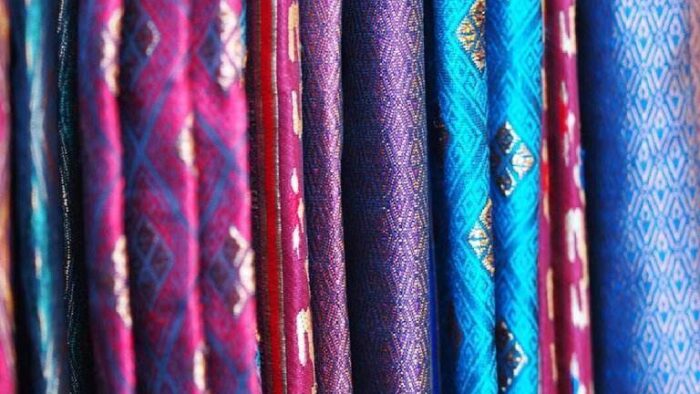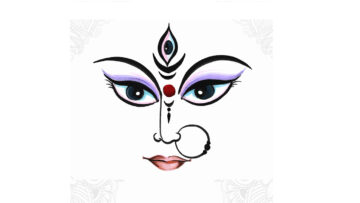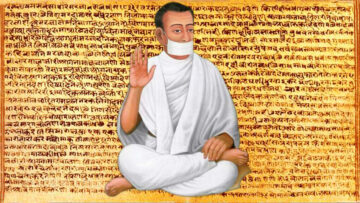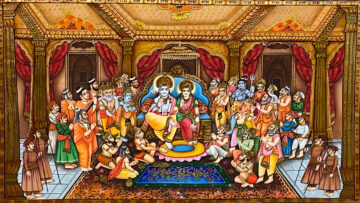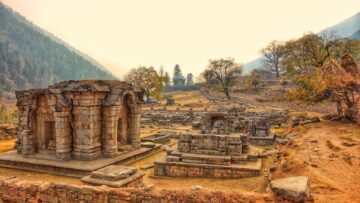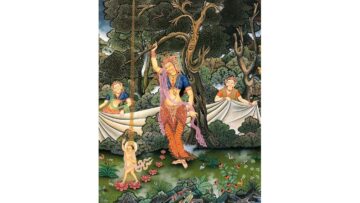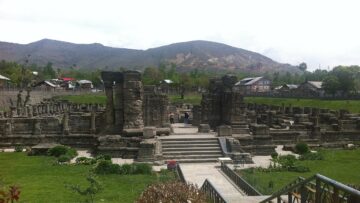Mainstream historical discussions have often focused more or less on great wars, monarchical exploits, technological developments, architectural and social developments, etc. Moreover, while analyzing past cultures we forget that they seem ancient to us, but historicity was not intrinsic in their existence. From the perspective of the ancient civilizations themselves, they were the pinnacle of modernity, the zenith of architectural technology and cultural developments. Aspects like ornamentation, presentation, styles, designs and aesthetics were not only known but also studied in those times. Therefore, the historical discussion should not be limited to philosophical and political discussions, it should also cover the mundane aspects of daily life. One such topic of discussion in history is clothing!
Within the purview of Indian textiles and costumes, Saree was the sole witness that saw the development of textiles from the beginning of civilization to the present day. It has always existed in one form or the other. The word saree is derived from the Sanskrit word ‘Shatika’ meaning a long piece of cloth. Ancient Indian philosophy has opined on the importance (or rather a superiority) of un-stitched clothes over the stitched ones. While the philosophical arguments have their own place, our focus lies on the history of saree in the Indian subcontinent. How did a single un-stitched piece of cloth manage to traverse centuries, dynasties, climatic conditions, textiles and draping styles to exist in the modern world in pretty much the same format with which it began?
Harappan Mother Goddess: Notice the waistband held skirt and shawl over the shoulders
To study the history of sarees, one has to go all the way back to the Harappan civilization and assess archeological evidences. Saree began as a three-piece outfit that were unconnected with each other. Statues of female figurines that have been identified as mother goddesses contain the most primitive versions of saree. The Harappan sculpture shows the presence of skirts and blouses complimented with intricate jewellery. References of modern-day saree are found in Rigveda, which is dated around 1500-1000 BC. The Rigveda mentions ‘Tantuvayas’ who were weavers of clothes. In Vedic age we find references of ‘nivi’ which was a pleated bunch of plaid tucked under the navel in a waistband. An additional scarf was wrapped around the waist to counter the transparency of cotton. The term ‘’nivi’ literally means ‘to gather’ and is found in both Sangam Tamil epic like Silapappadhikaram and Vedic literature. This has been understood to imply a pan-Indian identity of saree from the very beginning.
Vedic Era had costumes prescribed for every occasion. The first of the three broad styles include a lungi (modern day terminology) with a strip blouse. Another category of clothes belonged to the hunting-gathering communities that lived in rugged terrains and opted for minimal clothing, usually just a simple skirt around the waist. The third style was the Saree. In the Vedic age however, no sewn blouse was worn with the saree and it was just draped tightly around the upper body.
The Vedic literature has one interesting reference to Saree terminology. We find the term ‘pallav’ (literally meaning a tiny off-shoot in Sanskrit) to denote the loose end of the saree over the shoulder. The metaphoric comparison of the edge of the saree to a tiny off-shoot poking above the ground gradually degenerated over time to ‘pallu’. Incidentally the ‘pallav’ was the main canvas of artistic design in a saree. Even in Vedic age the pallav was dyed in different colours and patterns.

PICTURE: The primitive sari worn with no bodice. The ‘Adhariya’
Terms regarding Saree in Vedic Literature:
- Adhi vasa: Over-garment
- Paryanhana: Wrapped shawl
- Drapi: Embroidered Garment
- Usnisa: Headdress
- Atka: Flower Garments
- Hiranya Drapi: Gold/Silver/ finery/jewellery
Textile Historian Kamala Dongerkery marks the next important phase in the development of Saree between 320 BC to 320 AD. According to Dongerkery, by now regional/dynastic influences, fashionable trends, climatic conditions were reflected in clothing. Textual evidence points to the presence of around 8-10 ‘dresses’. New additions include primitive forms of Kurta, Legged-trousers, skirts, gowns, headdresses etc. A small cloth called ‘colaka’ was also used to show clan/Jana pada identities and was tied, tucked or sewn-in on the main costume.

Picture: Image of Maya/Lakshmi from the Sanchi Stupa, notice the draped head with the flower jewels and shawl.
Tailored costumes were well known, as evident from the numerous sculptural evidences from Patliputra. Concrete evidence of proper costume of women comes from the Mauryan sculpture of the Didarganj Yakshi from Patliputra. Speaking of female sculptures, it is also widely believed that women frequently kept their upper body decorated with just jewels based on the visual evidence, however it doesn’t necessarily match with the textual evidence. Although it might not be uncommon or tabooed, the climatic conditions would’ve not synced with it.

Didarganj Yakshi wearing the ‘Sakacha’. Notice how the end of the saree is now held in the hand. This shows the gradual progress of draping it from over the shoulder. Also notice the extra pleats tucked in the waistband.
Newer developments in Sari per se comes from 2nd century BC in Barhut, M.P. where a garment termed ‘Sakacha’ is seen in sculptures. Sakacha were tailored pyjamas or trousers and was adopted usually by working women. Often a pleated strip was attached in front to give the allusion of a saree, the end of which was extended along the back and draped over the shoulder quite similarly like the modern day ‘dupatta’ in the modern-day Rajasthani Poshak.

Bharhut sculpture of shalabhanjika. The proper ‘Sakacha’ with a turban drape.
The Shunga Period also saw the mass prevalence of headdresses that were worn by women in 2nd century BC. They were gradually replaced by waistbands/girdles by the Satvahana period. Desire for simplification probably led to discarding the headgear and simply looping the loose end of the Sakacha over the head.
The next period from 320 AD onwards saw the attachment of ‘turbans’ as part of the ‘male costume’. Around this time gender differentiation in clothes, the reasons for which are widely debated. The ‘Sakacha’ of the previous period underwent a two-pronged development where one ended up being the modern day ‘dhoti’ while the other (with the loose end reaching over the shoulder’ became ‘Saree’. Since this period also marks the beginning of the glorious Gupta Age Literature, we see ample evidences of women’s costumes in plays and books. Sculptural evidences from Sarnath, Deogarh, Gwalior, Mandor etc. are important sources of primary information.

Gupta Period Sculpture. Notice the stripes of the ‘pallav’ where the sari ends.
Under the Guptas, the art of ‘Calico Painting’ flourished that were significantly reflected in the elaborate designs and patterns in sarees. Chequers, stripes and swans were the most frequent motifs. ‘Amarakosha’ by Amarasimha has several details about the same. Amara details the process of Saree making. He refers to the cloth fresh off the loom as ‘anahata’ and ‘nispravani’ and the post bleaching cloth as ‘udgamaniya’. He mentions four types of textiles:
- Valka: Bark fibre
- Phala: Fibrous fruits/cotton
- Kauseya: Silk
- Kankava: Goat fur (animal fur in general)
Gupta Coins also provide examples. The opposite of Samudragupta’s coins contains Devi Lakshmi wearing a saree down to her ankles with a waistband and ‘Uttariya’ over her shoulder. Textual evidences for this period are sourced from Kalidas and Banabhatta. Kalidasa mentions ‘Krupasaka’ as a ‘close fitting bodice’ worn under the Saree. The underskirt also had developed around this time as the author refers to it while describing the twirling movements of a dancer. Besides Sari and Uttariya, Kalidasa mentions ‘Vaikaksya’ as another version of draping saree which was worn as a knotted piece of cloth above the shoulder and under the other arm. It is said to have resembled the ‘yajnapavita’. Banabhatta mentions ‘Pulakbandha’ sarees which is essentially the ‘tie-dye’ sarees with modern-day polka dots.

Gupta Coins: Samudragupta’s queen and Lakshmi’s coin on the right
Partly contemporary to the Gupta age was the famous Vakataka Dynasty in south-western India that witnessed the creation of the famous Ajanta Caves. Ajanta Cave paintings are a strong marker in the development in not only art but also the lifestyle of the time. Textile culture flourished under King Harsha in 7th century AD and his contemporary Pulakesin II who is credited with Cave I and II of Ajanta.
Deducing the Ajanta Cave paintings, we see that the royal women wore dhoti with elaborate headdresses and diadems. The women wore sarees with horizontal stripes along the length or a ghaghri with a profusion of jewels. Xuan Zhang who visited India in the 7th century mentions Mathura as a centre of production of the striped sarees. Around this time, the word ‘uttariya’ was developed to mean a rectangular piece of cloth that was worn as a shawl. Many Ajanta paintings have sarees with red and yellow stripes over plain white base (arguably the most accessible colours in nature). Attendants of royal women and men wore loincloths with jewels and waistbands. Tunics are also visible in the paintings.

Ajanta Cave Painting. Women wearing Saree with a coat. Notice the striped patterns on the bottom half.
Historian Moti Chandra who has deeply researched costumes and textiles between 3rd and the 10th century emphasizes that sewn dresses were also present in Gupta and Vakataka period. Ajanta paintings shows a woman in Cave I wearing a bodice of translucent gauze over a dhoti (with fine artistic detailing to show a wrinkly net-like textile). Right beside the famous Padmapani panel, a princess to the left of Bodhisattva wears a short skirt-saree with birds and ladders in horizontal pattern under a transparent gauze skirt. There’s another figure of a women in Cave I who has embroidered rosettes on her dresses. They all point to a highly developed sense of aesthetic. Often jackets were worn over sarees (preferably in winter), painting of a woman listening to Buddha’s sermon shows her donning a purplish jacket over a green saree.
The 9th and the 10th century saw further developments in textiles of sarees. Contemporary textual evidences point towards the increased use of silk. Silk had several varieties and sarees were accordingly named after them. ‘Patrona’ was wild silk while costly bleached silk was called ‘mahadhana’. ‘Amuska’ sarees were of a shining silk variety. Upper class women who were well-off preferred the ‘krmriga’ silk that was dyed in red along with the shiny ‘swarna’ silk that was spun by a special silkworm.
By the 10th century we see a cultural fixity in the identities of several regions within the Indian subcontinent. While the polity and population movement thrived, places and regions had definitely developed a distinct ‘culture’ that was reflected in the textiles too. Regions acquired distinct styles of draping sarees. By now, Choli had come into vogue as a compliment of ‘saree’. Western Indian cultures of Rajasthan and Saurashtra developed the ‘poshak’ which was a divided version of a saree. The 11th century in Gujarat saw the development of ‘Patola’ sarees with their centre at Anahillapatnam or Patan with designs reflected in the famous Rani Ki Vav.

Patola print and the Patola panels from Rani Ki Vav
The Malla dynasty with its spread in Bengal, Nepal and Bihar saw the earliest initiation of the Baluchari saree which then took several centuries to finally have its peak in the 16th and 17th centuries. Baluchari sarees and the temple paneling of Bishnupur drew inspiration from each other. The fertile ganga plains preferred the silky flowy texture of the Banarasi Sarees which textual traditions compared to the shimmering waves of Ganga under the sunlight. The Malwa-Bundelkhand region saw the origin of the Chanderi saree around the 13th century that were produced in both cotton and silk. The Bandhani (tie-dye sarees) mentioned before can be traced all the way back to the Harappan times. As per evidences in Historical Texts, the first Bandhani saree was worn at the time of Bana Bhatt`s Harshacharita in a royal marriage. They had definitely acquired their signature style in the 10th century AD.
The southern states had very well-developed styles of sarees mostly in Silk as they were home to the lowest end of the silk route. Mundum Neriyathum was a classic southern drape. Ikat sarees were also well known that later was used in the famous Pochampally sarees of present-day Telangana. Each of these Indic textiles have their own individual history intertwined with dynasties, technologies and cultural influences. A textile-wise study will be followed up in the next part of the series.
Featured Image Credits: parenting.firstcry.com
Disclaimer: The opinions expressed in this article belong to the author. Indic Today is neither responsible nor liable for the accuracy, completeness, suitability, or validity of any information in the article.

